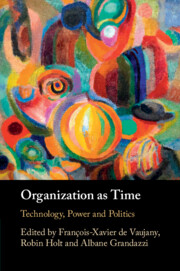Book contents
- Organization as Time
- Organization as Time
- Copyright page
- Contents
- Figures
- Tables
- Contributors
- Organization as Time
- Part I The Politics of Time: Ontologies and Metaphysics of Organization as Time
- Part II Re-orienting Critique in Organization Studies? Exploring Jointly Time and Politics
- Part III New Ways of Organizing Work, Digitality and the Politics of Time
- Part IV History and Duration: Making Things Last, Enduring Politics and Organizing
- 14 Times Alla Turca E Franga
- 15 Temporality and Institutional Maintenance
- 16 A Time for Justice?
- 17 Organizational Memory as Technology
- Conclusion: Time and Political Organizing
- Index
- References
16 - A Time for Justice?
Reflecting on the Many Facets of Time and Temporality in Justice Service Provision
from Part IV - History and Duration: Making Things Last, Enduring Politics and Organizing
Published online by Cambridge University Press: 22 June 2023
- Organization as Time
- Organization as Time
- Copyright page
- Contents
- Figures
- Tables
- Contributors
- Organization as Time
- Part I The Politics of Time: Ontologies and Metaphysics of Organization as Time
- Part II Re-orienting Critique in Organization Studies? Exploring Jointly Time and Politics
- Part III New Ways of Organizing Work, Digitality and the Politics of Time
- Part IV History and Duration: Making Things Last, Enduring Politics and Organizing
- 14 Times Alla Turca E Franga
- 15 Temporality and Institutional Maintenance
- 16 A Time for Justice?
- 17 Organizational Memory as Technology
- Conclusion: Time and Political Organizing
- Index
- References
Summary
This chapter explores the concept of time in the delivery of justice, reflecting on its multiple dimensions, roles and functions. Building on Orlikowski and Yates notion of temporal structuring, it investigates how people, material artefacts and legal rules defining judicial procedures and their legal performativity contribute to orienting ongoing activities and shaping temporal structures and their evolution trajectories. It addresses a gap in the existing literature exploring the effects on time structures and structuring of the intertwining of legal and technological performative requirements. The chapter looks at two key events, the filing of a case and the hearing, and two objects of time, the case register and the case file. It also describes the emergence of new temporal structures as procedures are digitised, and remote hearings replace courtroom hearings. It reflects on the emergence of new and simultaneously experienced and enacted perspectives on time, as the temporalities of the single procedure, its legal terms, deadlines and legal performativity requirements are joined by aggregated viewpoints, with new concepts such as disposition time, reasonable timeframe, and case weighting.
Keywords
- Type
- Chapter
- Information
- Organization as TimeTechnology, Power and Politics, pp. 349 - 374Publisher: Cambridge University PressPrint publication year: 2023

